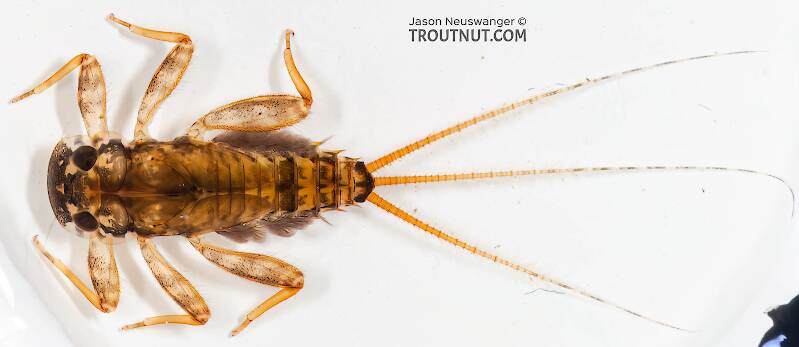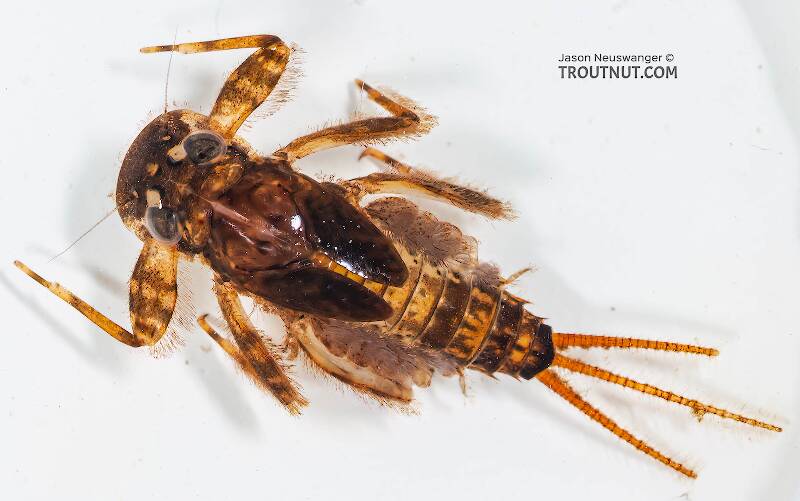
Hex Mayflies
Hexagenia limbata
The famous nocturnal Hex hatch of the Midwest (and a few other lucky locations) stirs to the surface mythically large brown trout that only touch streamers for the rest of the year.


Mayfly Species Stenonema mediopunctatum (Cream Cahills)
...the male only exhibits this coloration on segments eight to ten, against an otherwise whitish to translucent body.
Where & when
Time of year : Late June to early October, peaking in early August
In 5 records from GBIF, adults of this species have been collected during July (80%) and June (20%).
Species Range
Nymph biology
Current speed: Fast
Substrate: Gravel and rock
Physical description
Most physical descriptions on Troutnut are direct or slightly edited quotes from the original scientific sources describing or updating the species, although there may be errors in copying them to this website. Such descriptions aren't always definitive, because species often turn out to be more variable than the original describers observed. In some cases, only a single specimen was described! However, they are useful starting points.
Male Spinner
Wing length: 8-10 mm
A species of Stenonema pulchellum group; thorax almost wholly deep black brown; spiracular dots usually present; tails not, darker at joinings.
Frontal portion of head pale whitish; vertex sepia brown with ruddy shading next to the eyes. Thorax, dorsally and ventrally, deep black brown, except a whitish patch on pleura anterior to wing roots and slight paler shading below wing roots. Posterior portion of scutellum with faint paler shading; a small whitish median dot anterior to scutellum, and two small white lateral streaks. Legs whitish; median and apical purplish bands on femora; fore tarsus black-tipped at apex; basal joint of fore tarsus more than half as long as second. Wings hyaline; veins fine, black, cross veins in costo-apical region slightly thickened.
Abdominal segments 2-7 hyaline white; scarcely a trace of darker posterior margins, only a small dark transverse dash on posterior margin of each, at mid-dorsal line. Black spiracular dots present on segments 4-7 (may be obsolete). Segments 8-10 opaque, whitish; tergite 8 in posterior half, and all of 9, shaded with light sepia brown. Forceps whitish; genitalia of the pulchellum type(?). Tails wholly white, not darker at joinings.
The very dark thorax, short dark median dash on tergites and fine veins distinguish this species from its near allies.
Described as S. nepotellum subspecies mediopunctatum
Body length 8 mm, wing length 8-10 mm
A species of the Stenonema pulchellum group; spiracular dots present; tails dark-ringed; reddish stain in stigmatic area of fore wing.
Head very similar to S. rubromaculatum (now a synonym of Stenonema modestum). Mesonotum ochre-brown; anterolateral margins narrowly whitish. Scutellum whitish, also lateral margins to base of fore wing. Metanotum largely ochre-brown; median elevation whitish. Pleura yellowish-white, with brown shading as in rubromaculatum; anterior to wing roots shaded with light reddish. Legs very much as in rubromaculatum; posterior margin of fore coxa narrowly black; less reddish shading laterally than in that species; purplish bands on femora also less distinct, may be wanting on hind leg. Wings as in rubromaculatum.
Abdominal segments 1-7 hyaline, pale yellowish white; posterior margins of tergites somewhat more distinctly black than in rubromaculatum; black spiracular dots well defined. Segments 8-10 opaque white; tergites largely suffused with pinkish brown; on anterior margin of 8, slight pale submedian wedge-shaped marks; posterior margin of 10 also white. Genitalia of rubromaculatum type. Tails pale; joinings narrowly brown.
In the imago stage, this species is very close to S. rubromaculatum and S. annexum (now a synonym of Stenonema modestum); may be distinguished as indicated under those species. Ventral markings of nymph are distinct from either of these, and very similar likewise to Stenonema ithaca.
Specimens of the Mayfly Species Stenonema mediopunctatum
2 Nymphs
Discussions of Stenonema mediopunctatum
In this section, the Midwestern nymphs (#573 & #574) with the dark irregular ventral bars across the anterior portion of the sternites look like Maccaffertium mediopunctatum arwini (the Midwestern ssp.), but the two Eastern duns (#733 & #765) and the associated shuck (of #765) and nymph (#764) look more like Maccaffertium ithaca to me.
Three Maccaffertium species can have very similar ventral markings in the nymph—dark, sinuate, chevron-shaped bars on many of the sternites and dark lateral marks (sometimes connected to form an inverted U-shaped mark) on segment 9. The Eastern mediopunctatum subspecies, M. m. mediopunctatum, has these markings, as does M. ithaca. Similar markings also appear as a less-common variant marking of M. modestum (or the M. modestum species complex). However, these species differ in the length and location of posterolateral projections, leg markings, the appearance of the subs and adults, and size.
Although interpretation of posterolateral projections can be tricky, those projections should help to separate the nymph (and husk) from mediopunctatum. On mediopunctatum, projections are usually on segments 3-9, 4-9, or 5-9, and those on 8 and 9 are fairly long. On ithaca, projections are usually on segments 6-9 or 7-9, and those on 8 and 9 are somewhat shorter (when compared to mediopunctatum). The twin brown bands on the femora of the nymphs should also help to separate them from modestum and mediopunctatum (usually three or four in those species).
The brown posterior margins and median dorsal stripes of the duns (similar to those found in M. vicarium) are typical of ithaca. In McDunnough’s original description of mediopunctatum (1926), he mentions that some of his (paratype) specimens were reared from subimagos, and he describes those subimagos as “quite pale whitish in coloration.”
Size might also be somewhat helpful in distinguishing these specimens from M. m. mediopunctatum (about 7-10 mm at maturity) and modestum (about 8-11 mm at maturity). M. ithaca is about 9-14 mm at maturity. The relatively mature nymph (#764) is at least 11 mm, the female dun (#733) is about 13 mm, and the male dun (#765) is about 11 mm.
When all of these factors are considered, it seems to me that M. ithaca is a more likely ID for the Eastern specimens. (See Bednarik and McCafferty 1979 and Lewis 1974.) I would suggest the following placement for specimens currently in this section:
M. ithaca nymph: http://www.troutnut.com/specimen/764
M. ithaca female dun: http://www.troutnut.com/specimen/733
M. ithaca male dun: http://www.troutnut.com/specimen/765
M. mediopunctatum arwini nymph: http://www.troutnut.com/specimen/573
M. mediopunctatum arwini nymph: http://www.troutnut.com/specimen/574
Best,
Lloyd
Start a Discussion of Stenonema mediopunctatum
References
- Baumann, Richard W. 1975. Revision of the Stonefly Family Nemouridae (plecoptera) : a Study Of The World Fauna At The Generic Level. Smithsonian Contributions to Zoology undef(211): 1-74.
- Knopp, Malcolm and Robert Cormier. 1997. Mayflies: An Angler's Study of Trout Water Ephemeroptera . The Lyons Press.
- Leonard, Justin W. and Fannie A. Leonard. 1962. Mayflies of Michigan Trout Streams. Cranbrook Institute of Science.
- Needham, James G., Jay R. Traver, and Yin-Chi Hsu. 1935. The Biology of Mayflies. Comstock Publishing Company, Inc.
Mayfly Species Stenonema mediopunctatum (Cream Cahills)
Species Range
Common Name
Resources
- NatureServe
- Integrated Taxonomic Information System
- Global Biodiversity Information Facility
- Described by McDunnough (1926)



